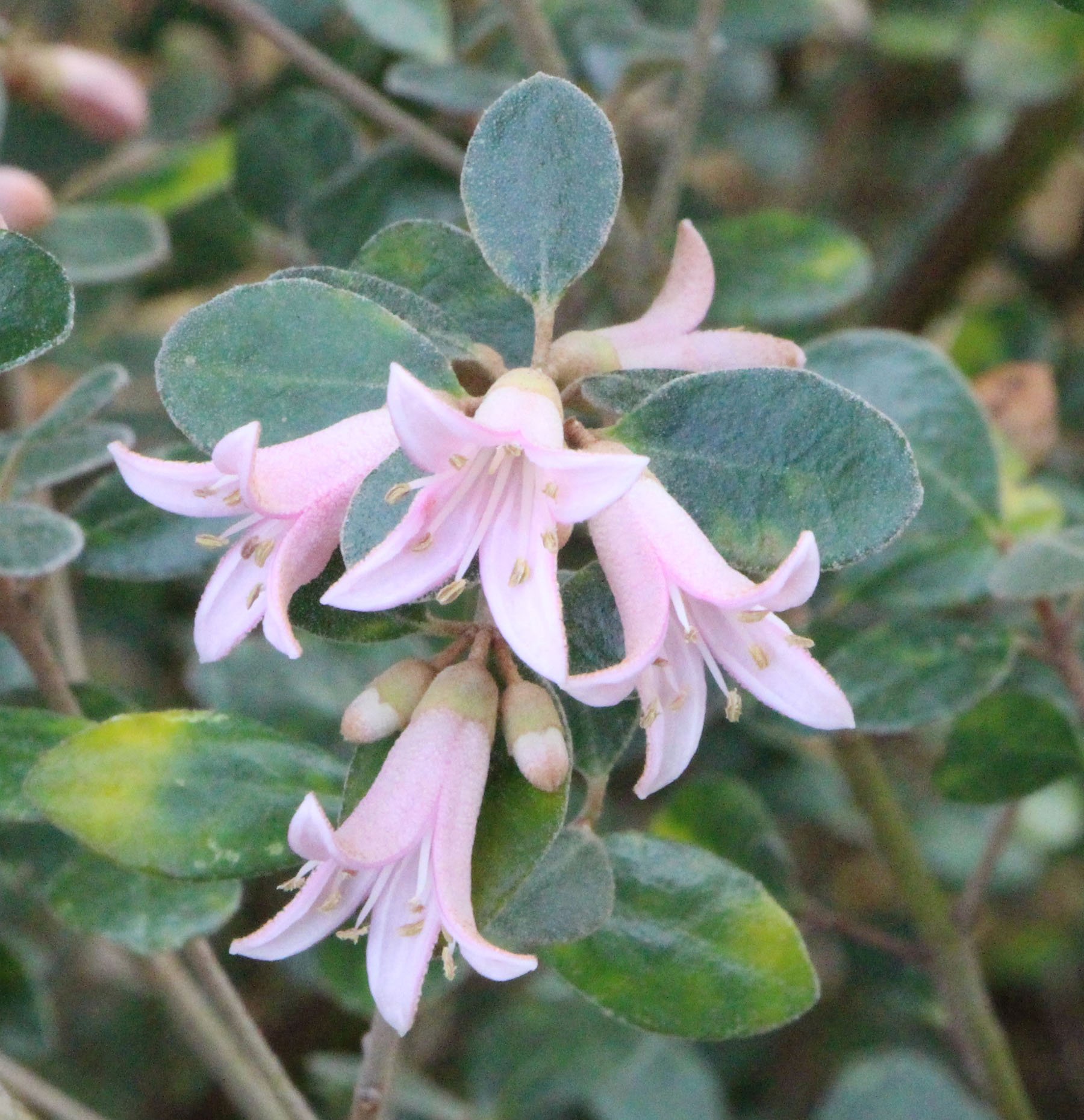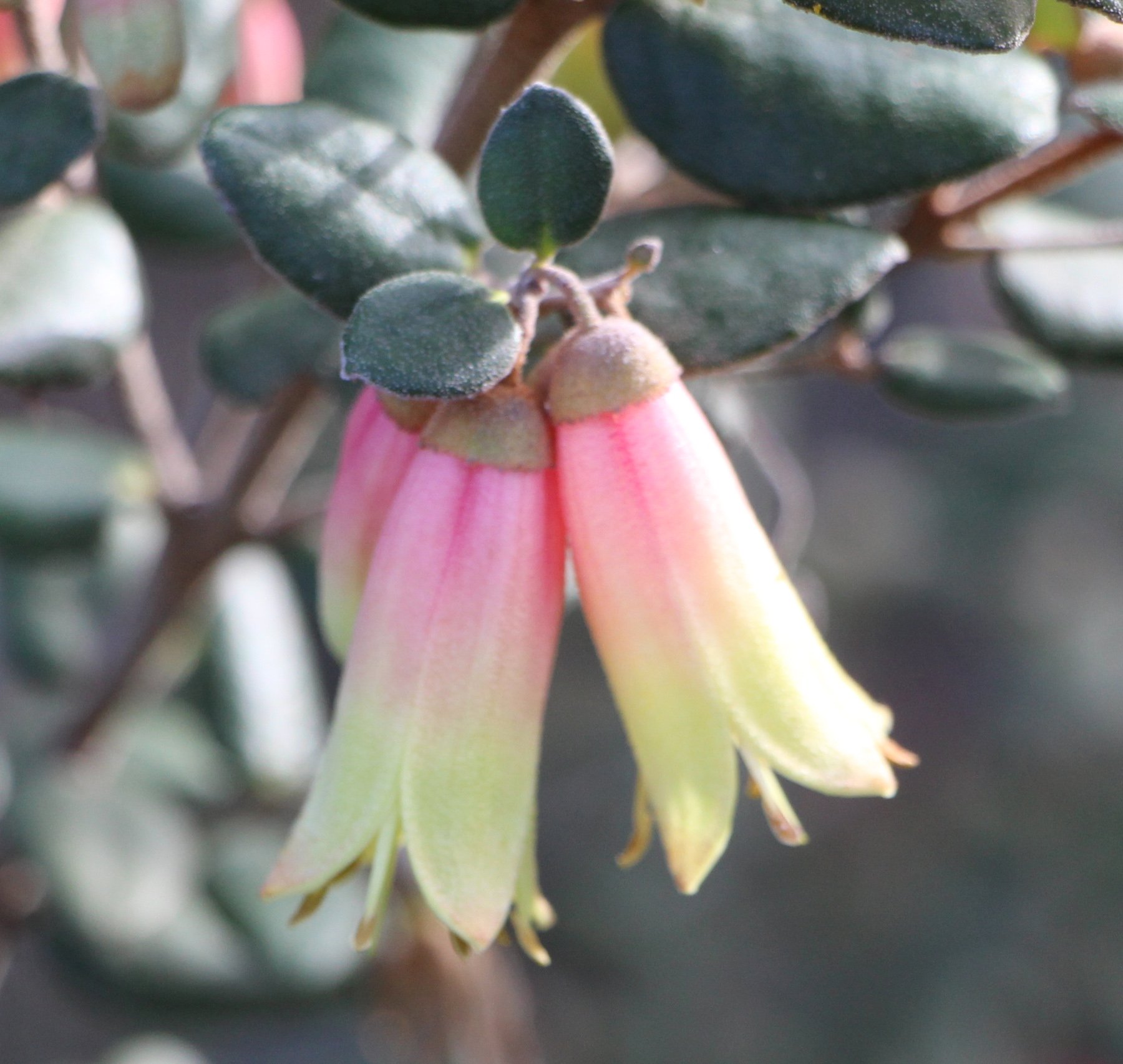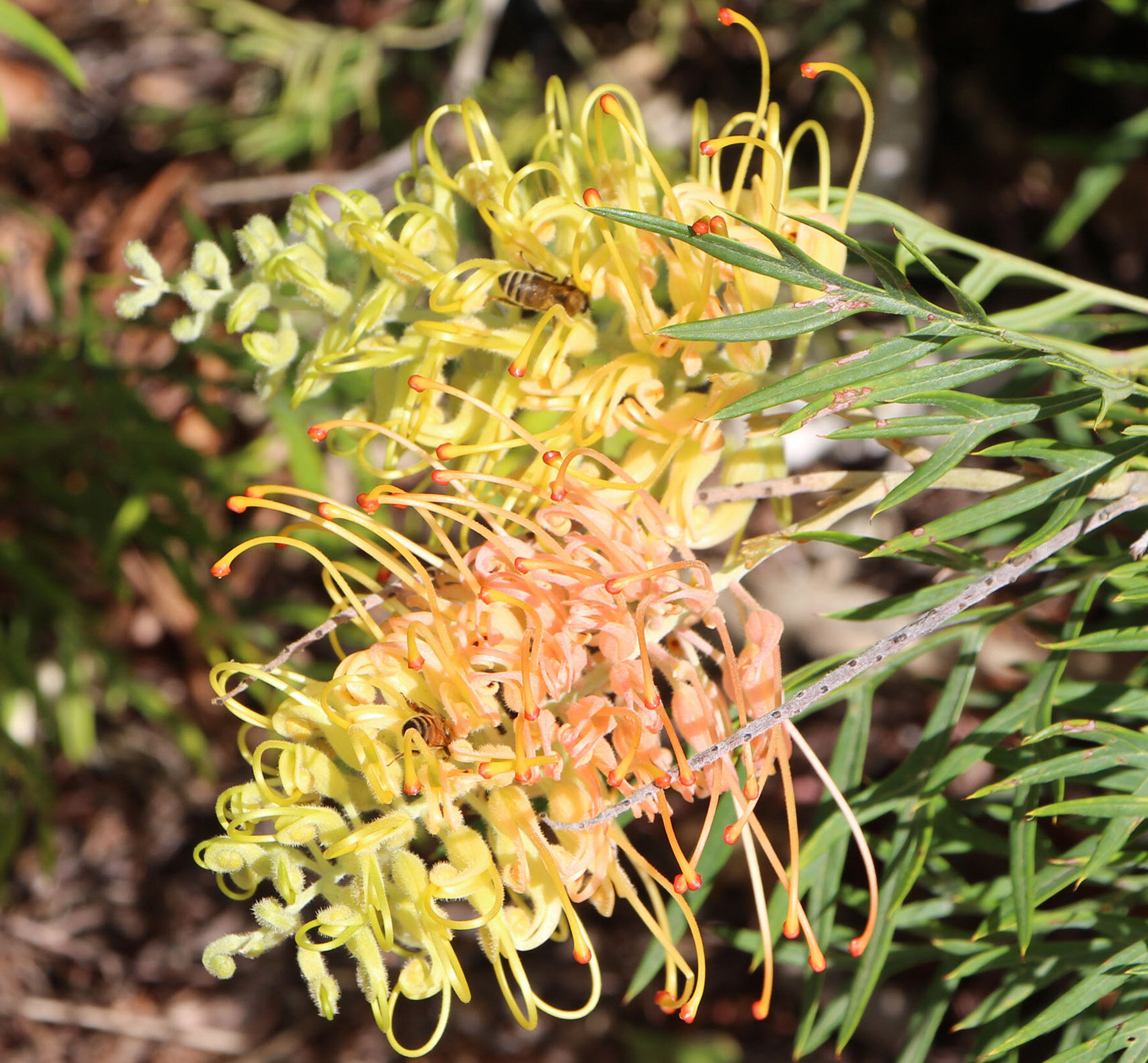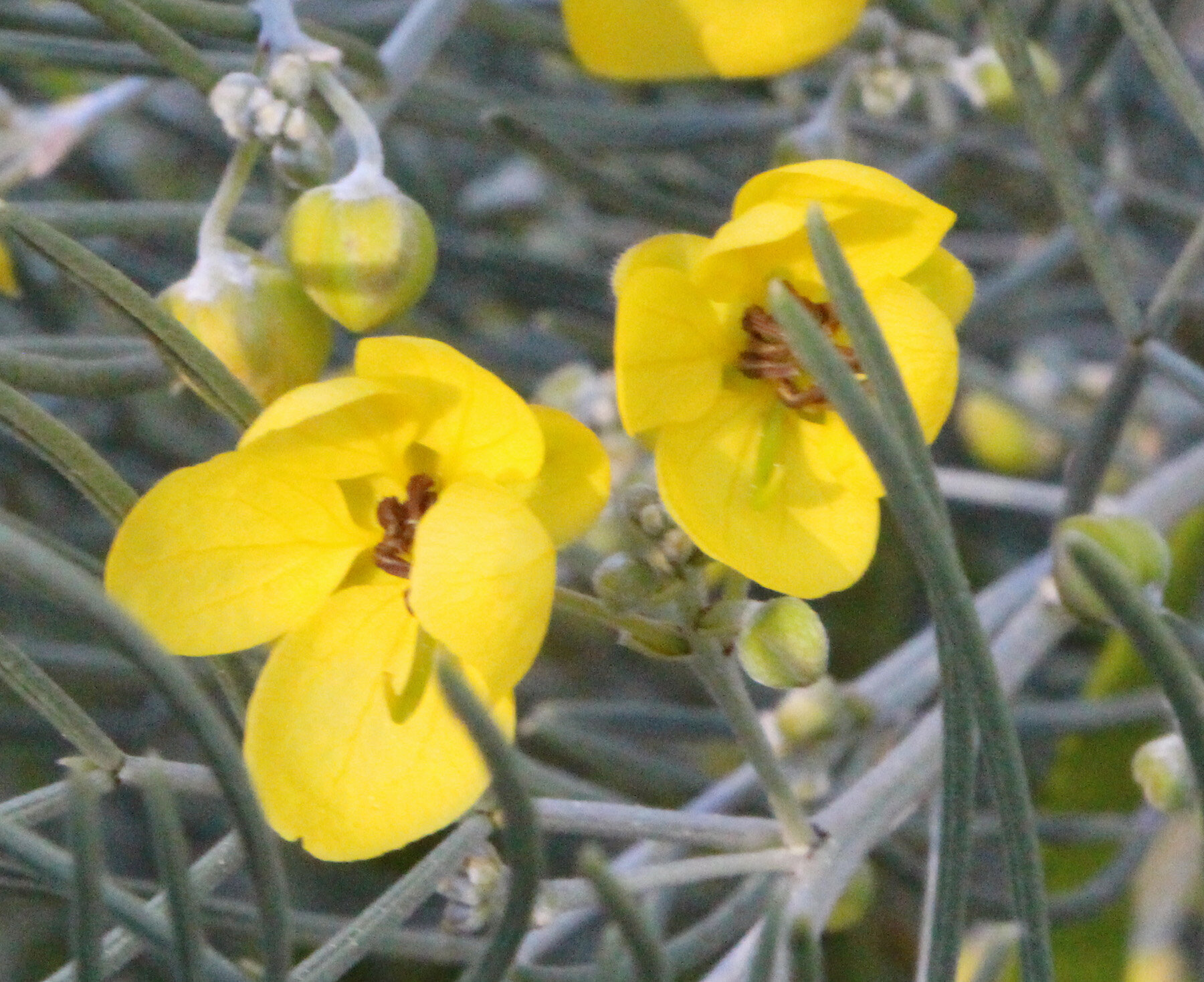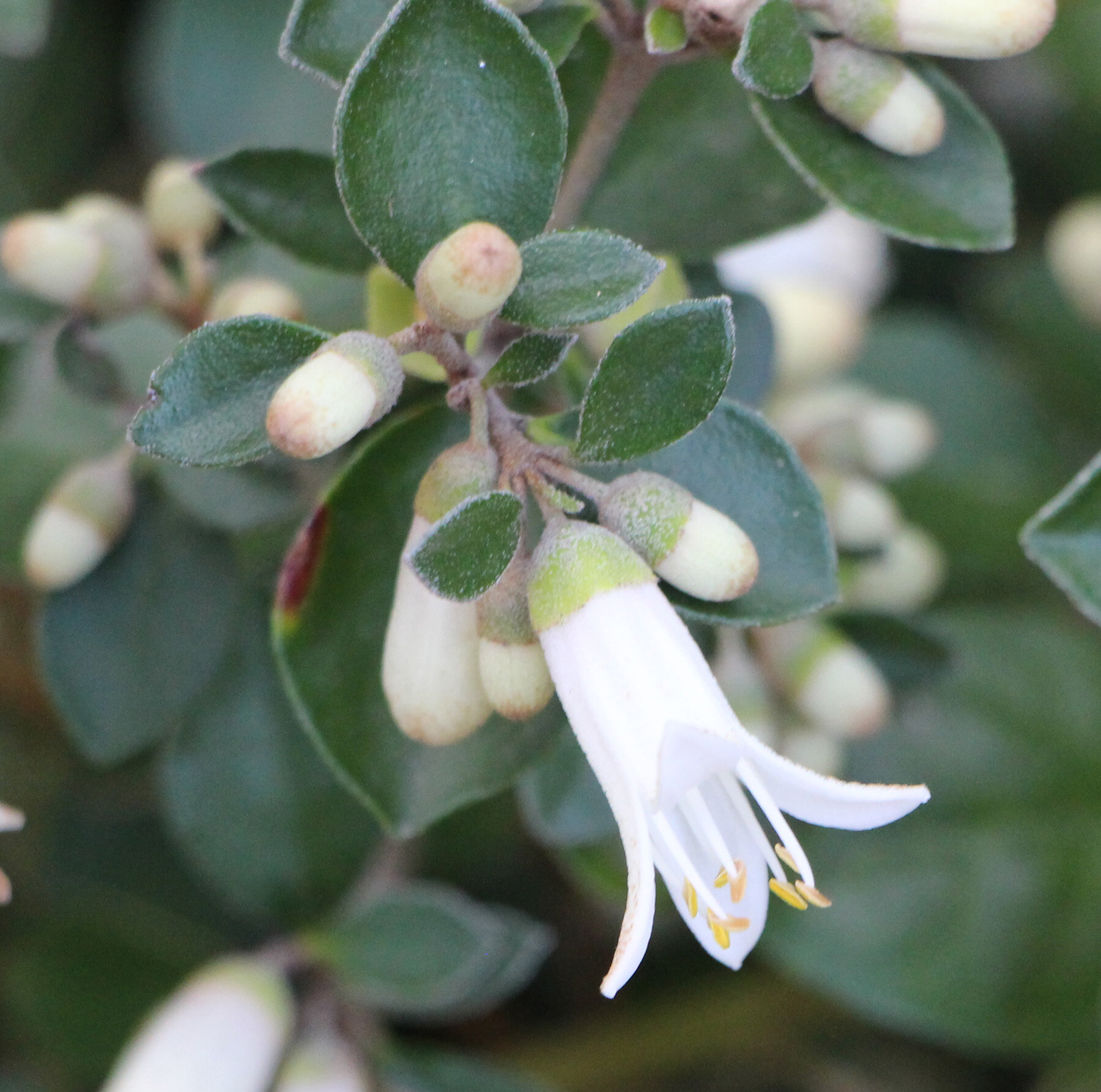April
A few plants that are in bloom in April
Click on any image to enlarge and scroll though all the images for each week.
Senna barronfieldii (S. odorata)
7 April 2025
Starting from the top left:
Banksia ‘Yellow Wing’
We planted nine of these banksia hybrids in 2006, Banksia ‘Giant Candles’ x B. spinulosa (Carnarvon Gold) ‘Birdwire’. They form a rounded shrub, 1.5-1.8m x 1.5x1.8m wide, with fine dense foliage and many orange nectar-rich flowers. The flower spikes are held well above the foliage which attract a range of nectar eating birds, and parrots love their seed.
Correa ‘Dusky Bells’
We planted 34 of these low spreading shrubs, 60 cm high, with bright green oval foliage and deep pink bell shaped flowers, as part of our foundation planting in 2003. ‘Dusky Bells’ is a very popular, easily grown, compact shrub in an open sunny position with good drainage. Since the original planting we have added another ten of these durable shrubs to our garden. We removed many of these in October 2022 to make room for other plantings.
Correa reflexa x decumbens ‘Redex’
We have planted thirty of these narrow shrubs, 1m high x 0.8m wide, with small, tough, shiny crinkled leaves and red and yellow bird attracting flowers, from 2004-21. This cultivar arose in Kangaroo Island SA, and is thought to be a natural hybrid of Correa reflexa and C. decumbens. We have lost some over the years, but this plant is very floriferous and frost resistant and remains a favourite in our garden.
Correa ‘Summer Belle’
We have planted five of these spreading shrubs, 1m high x 1.5m wide, with shiny, dark green leaves and pink flowers with green tips. This plant arose as a garden seedling from Neil Marriott of Stawell in Victoria.
Pennisetum alopecuroides – Swamp Foxtail
We planted 50 of these tussock forming grasses with narrow arching leaves and feathery purplish flower heads on erect stems to 1m high. These plants are hardy in most soils, even those not well drained, and are best grown in full sun. We removed many of these in the garden, but they have persisted around our water features. We cut them right back each year for better growth. These plants are native to both Australia and Asia.
Plectranthus (Coleus) argentatus
We planted this spreading shrub, 50cm x 1.5m, with large, velvety, silver foliage and whitish flowers, one in 2017 which was immediately eaten to the ground, and another in 2019 which is thriving. These plants need a semi-shaded position with some protection from frost. We have planted another 20 cuttings in December 2022. This plant is native to southeastern Queenlsand and northeastern NSW.
22 April 2024
Starting from the top left:
Callistemon ‘Hot Pink’
Callistemon ‘Hot Pink’ is another hybrid, C. splendens x pallidus, forming a shrub 1.5m high x 1m wide, with pink new growth and hot pink flowers. We planted one in September 2015 and it has grown and flowered well.
Correa ‘Lucy’
We have planted seven of these hardy shrubs, 2022-23, 1m high and wide, with many pink curved bell flowers over a long period. These plants prefer part shade to full sun.
Correa ‘Snowbelle’
We planted two of these spreading shrubs, 1m high x 1.5m wide, with dainty white flowers over a long period, in April 2020 and June 2022.
Eremophila glandulifera ‘Lipstick Pink’ - grafted
We planted this upright shrub with attractive grey foliage and lolly pink flowers in a pot in December 2019. This plant is from central WA and can grow to a height of 1.5m, although only small for us so far.
Hakea clavata
We have planted two of these shrubs, 1.5m high x 2.5m wide, with succulent like leaves and pale pink to white flowers, in March 2012 and November 2019. The foliage is unusual and a feature of the plant. Our first specimen, planted in March 2012, was hit by the frost in October of the same year and died. The second one we planted in pot in November 2019 and it is growing well so far and flowered for the first time in October 2021. This plant is native to the Esperance area of WA and is adapted to harsh conditions. Terrific all-over flowering in April 2025.
Phebalium nottii pink
We planted this mall bushy shrub to 1m high with dark foliage and clusters of pink star flowers in April 2021. This plant is frost and drought tolerant and is native to northern NSW and southern Queensland. The first blooms were in June 2021. We have planted another six in 2022-23. All gone by 2025.
8 April 2024
Starting from the top left:
Banksia pulchella – Teasel Banksia (grafted)
We planted a grafted specimen of this plant in April 2009. The species name is from the Latin for pretty. The shrub grows to 1m high and flowers with brownish-yellow teasel flowers with unusual grey, knobbly fruiting cones. Our plant has flowered reliably since April 2010. This plant is native to the south coast of Western Australia, near Esperance. The type collection was by Robert Brown in January 1802, Lucky Bay, WA.
Correa alba ‘Star Showers’
We planted this prostrate groundcover, height 0.3m x width 1m, with silver foliage and dainty white star shaped flowers in November 2019. This plant will grow in full sun to dappled shade and is frost tolerant. We planted another four in May 2023, three of which have died.
Correa ‘Catie Bec’
We have planted six of these shrubs, 1m x 1.5m wide, with pretty upturned pink flowers, over the period 2018-21. In our garden they need some overhead protection. We planted five more in October 2023.
Correa pulchella – Wild Fuchsia
We have planted 15 of these correas, 1m x 1m, with decorative salmon bell flowers from 2005-19. This small neat shrub from South Australia provides great winter color, and prefers moist well drained soils in a sunny to partly shaded position.
Correa sp. hybrid (lemon)
We planted five of these prostrate shrubs, 0.2-0.5m high x 0.5- 1m wide, with dark green leaves and short wide creamy lemon flowers in October 2018. We have three remaining as two died in the heat of January 2020.
Correa ‘Windsong’
We planted three of these Correa reflexa hybrids, 30cm high x 2m wide, a mounding groundcover with greyish foliage and pastel pink and white flowers, in July 2021. Unfortunately one plant drowned in the rain in October 2022
24 April 2023
Strarting from the top left:
Correa calycina
We planted three of these dense shrubs that may reach 3m high by 2m across, with soft, oblong leaves with rusty backs and green flowers, in March 2007. Although the flowers are not well displayed birds are attracted to them. This plant is native to the Fleurieu Peninsula, SA and is endangered in the wild.
Correa ‘Coastal Pink’
We have planted seven plants of this form of Correa alba with pink flowers, growing to 2m x 2m, but only three remain.
Correa ‘Catie Bec’
We have planted six of these shrubs, 1m x 1.5m wide, with pretty pink flowers, over the period 2018-21. In our garden they need some overhead protection.
Correa 'Marian's Marvel'
We have planted 22 of this hybrid between C. backhousiana and C. reflexa, 2 m by 3 m across, from 2003-2019. This plant has dark green foliage and bell shaped flowers which are pink in upper section and lime green near the tip. Originally we took the advice that these plants liked shade and we had only mixed success with them. We then saw them growing beautifully in full sun at Murrumbateman, and tried cuttings from our original plants in a similar position. These plants have grown and flowered extremely well and frost does not bother them at all.
Correa reflexa x decumbens ‘Redex’
We have planted thirty of these narrow shrubs, 1m high x 0.8m wide, with small, tough, shiny crinkled leaves and red and yellow bird attracting flowers, from 2004-21. This cultivar arose in Kangaroo Island SA, and is thought to be a natural hybrid of Correa reflexa and C. decumbens. We have lost come over the years, but this plant is very floriferous and frost resistant and remains a favourite in our garden.
Syzygium australe
We planted three Syzygium australe in December 2008. These shrubs grow to 3m high and have attractive red new growth, fluffy white flowers over a long period and shiny pink-purple fruits. Our three have been regularly blasted by frost and lose all their leaves during winter, but regenerate when the weather warms up. This plant is native to Queensland and New South Wales, northwards from Batemans Bay.
25 April 2022
Correa ‘Coastal Pink’
We have planted seven plants of this form of Correa alba with pink flowers, growing to 2m x 2m, but only three remain.
Correa ‘Win’s Wonder’
We planted two Correa ‘Win’s Wonder’ , 1.5m high x 1.2m wide, with green and cream variegated leaves which contrast well with the bright red flowers., in November 2016. One plant died in the heat, but the other survives.
Grevillea ‘Wild Gold’
We planted this bushy low-growing shrub, 1m high x 2m wide, with dense, lime-green foliage and large yellow flower clusters , in August 2019. This plant grows best in well drained soil in full or partial sun, is bird attracting and first bloomed for us in September 2021.
Paraserianthes lophantha – Cape Leeuwin Wattle or Plume Albizia
We planted this fast growing tree to 10m high, with fine bipinnate foliage and iridescent yellow-green toothbrush flowers, in January 2021. This plant is native to southwestern WA, from Fremantle to King George Sound. While it is strictly neither a wattle nor an albizia despite its common names, this tree has grown to 3m high and is flowering for the first time in April 2022. I have placed this plant in a very protected area with lots of sun, it has made it through one Canberra winter, and I have high hopes that it will continue to cope.
Veronica arenaria
We have planted 20 of these small to medium shrubs, 0.6-1.5m high x 1-2m wide, with narrow leaves and violet-blue flowers from 2013. Twelve of them have died out over time, but the seven remaining and one volunteer in another part of the garden all bloom well. This plant is native from southeastern Queensland to the central west slopes of New South Wales.
Xanthorrhorea quadrangulata - Yucca
We planted nine of these slow growing grass like shrubs with tall flower spikes as tubestock from Australian Arid Lands Botanic Gardens, in September 2017. These plants are endemic to South Australia. All nine are growing slowly and this year, 2021, one has flowered. Three more have flowered in 2022.
18 April 2022
Acacia subulata – Awl Wattle
We planted this small tree, 1.5 – 4m high and 1-2m wide, with a slender habit, narrow graceful foliage and showy yellow ball flowers, in August 2016. This plant is native to northeastern NSW along the ranges and slopes. This wattle blooms all year, in a serial fashion, from branch tip upwards, smells delicious, has delightful light ferny foliage, decorative seed pods and grows fast.
Banksia menziesii (dwarf)
We planted this banksia, with toothed leaves and pink-mauve flowers in winter, in a pot, in March 2010. This plant grows to height 2m, width 2m, and is native to the central west coast of Western Australia.
Brachyscome ‘White Delight’
We planted three Brachyscome ‘White Delight’ in December 2008 and they grew and flowered well, height 25cm, with finely divided dark green leaves and white daisy flowers with yellow centres. Ben made a number of cuttings of this plant and we planted 15 in May 2010. These grew and multiplied, so Ben made even more cuttings and we planted 25 of these in September 2012. Since then these plants have grown well and flowered over long periods. They light up dark areas of the garden and are very reliable.
Correa ‘Mallee Pastel’
We planted two of these groundcover shrubs, height 30cm x width 1m, with pastel pink flowers, in 2016. Both have grown well and flower reliably each year.
Eremophila glabra ‘Fruit Salad’
We planted six of these vigorous, prostrate plants, 0.3m high x 1.5m wide, with bright green leaves and attractive red and yellow flowers, in February 2015. We have since had to cut them back severely to prevent them from taking over the garden bed.
Hakea coriacea - Pink Spike Hakea
We have planted four Hakea coriacea, or Pink Spike Hakea, the first three in the garden, all of which met a sticky end. Two of them were blown over in the wind. They were rotted out at the base as our garden is a bit too wet for them. This shrub, 2-4m high and 2-3m wide, with grey-green leathery leaves and pink spikes of flower, comes from the Kalgoorlie area, WA. We planted one in a pot in November 2013 then moved it into the garden in December 2016. This plant is now 3m high and has bloomed sparingly. I wished for more blooms which arrived in spring 2021 with the extra La Nina rain
11 April 2022
Acacia beckleri - Barrier Range Wattle
We have planted three of these shrubs to 3m high, often spreading widely, native to the Gawler Range and the northeastern Eyre Peninsula, SA, then further east to Cobar and Jerilderie NSW. The first one, planted November 2013, died December 2014, but the other two are persisting and flowering March 2021 and 2022.
Alyxia ruscifolia
Moonya is an erect shrub, 3m high x 1.5m wide, although the one we planted in May 2009 has only grown to 1.5m high and wide, and flowered for the first time in April 2012. Dark green glossy leaves, perfumed white flowers and orange fruit make this an attractive shrub for a protected spot in the garden. This plant comes from the rainforest areas of Queensland, Northern Territory, NSW and Papua New Guinea.
Banksia spinulosa ‘Honey Pots’
We have planted ten of these shrubs, 0.5m high x 0.5m wide, with nectar rich orange flowers from late summer through to spring. Our original shrub, planted in April 2006, has grown to 1.5m high and wide, much larger than advertised on the label.
Correa 'Pink VoVo'
We planted this Correa backhouseana x reflexa hybrid, 1.2 m high x 1.5 m wide, an open shrub with pink and cream bell flowers, in October 2013.
Eremophila alternifolia x Myoporum platycarpum
We have planted two of these open plants, 2.5m high x 2m wide, with narrow, dark green leaves and scattered delicate pink flowers, in 2009 and 2013. Although covered with shadecloth the first succumbed to frost in August 2009. The second continues to flower over many months.
Grevillea drummondii – Drummond’s Grevillea
We planted this shrub in July 2020, to 3m high and 1.5m wide, with softly hairy, dark green foliage and yellow-orange flowers which crowd in the leaf axils and age to pink or red creating a bicolour look. This plant is native to Perth area, WA and is named after the Scotsman, James Drummond, 1784-1863.
5 April 2021
Starting from the top left:
Eremophila ‘Mallee Lipstick’
We planted a group of 8 ‘Mallee Lipstick’, a cross between E. glabra and E. maculata, in 2014-5. These plants form a shrub 1m high and 1.5m wide with grey green leaves and bright pink flowers over many months. They are very vigorous and benefit from pruning.
Eremophila oppositifolia ‘Hardy Harry’
We planted this shrub, 2.5m high x 1.5m wide, with lovely grey foliage and pinkish-white flowers over a long period, in October 2010.
Grevillea ‘Peaches and Cream’
We planted this slightly frost sensitive plant, developed by Denis Cox and Jan Glazebrook, 1.2m high x 1.5m wide with attractive divided foliage and peach and cream flowers in profusion during summer. This plant needs a little protection in Canberra, but is worth the bother.
Grevillea ‘Carol Ann’
We planted three of these low shrubs, 2m in width, with dense prickly foliage and dark red spider flowers - one planted April 2013 and the other two in October 2016. This plant is a favourite for bees and a non-stop performer for us.
Grevillea x ‘Semperflorens’
This cultivar was developed in England and was first formally described in 1937 by F.E. Briggs in The Journal of the Royal Horticultural Society of London as Grevillea semperflorens. We planted three in September 2007 and quickly realised our mistake as they grew much too large for their position and had to be removed. We planted another in February 2019 in a better spot, but this one disappeared for a few months, but has now reappeared and is flowering. The flowers are a lovely soft apricot colour.
12 April 2021
Starting from the top left:
Callistemon ‘Pink Champagne’
‘Pink Champagne’, of all our many callistemons, is the one that blooms the most and looks the best. We have planted 17 of this variety over the years 2004-8. This plant forms a tall shrub, 3m x 2m, with beautiful flushes of pink flowers several times a year in a sunny position with adequate water.
Correa ‘Redex’
A cross between C. reflexa and C. decumbens, ‘Redex’ has small tough, shiny leaves and masses of red and yellow bird attracting flowers over a long period. This plant is one of the best performing of our many correas in full or filtered sun, in wet or dry positions .We have planted thirty of these shrubs over the years 2004-21.
Senna artemisioides – Silver Cassia
We planted four Senna artemisioides, or Silver Cassia, from 2004-2007, but only one remains and it has resurrected itself after being cut to the ground in December 2014. This plant has beautiful silver-grey pinnate leaves and yellow cup flowers and is native to inland mainland Australia.
Senna barronfieldii
We have planted ten Senna barronfieldii, (syn. Senna odorata), since we obtained our original plant from Maria Hitchcock in October 2013. This plant is a spreading low shrub, 0.5m high and 1m wide, with fern-like green foliage and long lasting yellow cup flowers, followed by prominent black seed pods. This plant is native to eastern Queensland and NSW.
Swainsona galegifolia burgundy – Darling Pea
We have planted dozens of Swainsona galegifolia burgundy, or Darling Pea, in our garden mostly grown from the black seed pods which develop after the sprays of burgundy pea flowers have finished. These plants grow to 1.5m high with greyish pinnate leaves on dense branches. This plant is native to inland NSW and Queensland.
Syzygium australe
We planted three Syzygium australe in December 2008. These shrubs grow to 3m high and have attractive red new growth, fluffy white flowers over a long period and shiny pink-purple fruits. Our three have been regularly blasted by frost and lose all their leaves during winter, but regenerate when the weather warms up.
19 April 2021
Starting from the top left:
Banksia pulchella (grafted)
We planted this shrub, 1m high, with teasel like flowers and unusual grey, knobbly fruiting cones, in April 2009. The species name is from the Latin for pretty. The type collection was by Robert Brown in January 1802, Lucky Bay, WA.
Banksia seminuda – River Banksia
We planted this quick-growing erect tree, 5-15m high by 2-4m wide, with attractive dark green foliage, silver underneath, and large red and gold flowers in August 2016. Ben grew our plant from seed and the tree has now reached 7m high and 3m wide. We were rewarded with fifty blooms in March 2022 with the extra rain of a La Nina year.
Alyogyne huegelii ‘Misty’
We planted three of these shrubs, with attractive bluish foliage and many lilac flowers with a burgundy centre, in December 2018.
Androcalva loxophylla (Rulingia kempeana)
We have planted five of these erect shrubs, 1.5m high x 1.5m wide, with small hairy green leaves with toothed margins and bright yellow flowers at the base of leaves, over the period 2015-18. This plant is native to WA, SA, NT and Queensland.
Correa ‘Catie Bec’
We have planted six of these shrubs, 1m x 1.5m wide, with pretty pink flowers, over the period 2018-21. In our garden they need some overhead protection.
26 April 2021
Starting from the top left:
Alyxia ruscifolia - Moonya
Moonya is an erect shrub to 3m high and 1.5m wide, although the one we planted in May 2009 has only grown to 1.5m high and wide and flowered for the first time in April 2012. Dark green glossy leaves, perfumed white flowers and orange fruit make this an attractive shrub for a protected spot in the garden. This plant comes from the rainforest areas of Queensland, Northern Territory, NSW and Papua New Guinea.
Banksia ‘Yellow Wing’
We planted eight of these hybrid banksias, Banksia ‘Giant Candles’ x B. spinulosa (Carnarvon Gold) ‘Birdwire’, 1.5-1.8m high x 1.5x1.8m wide , with fine dense foliage and orange flowers, in February 2006. The flower spikes are held well above the foliage which attracts a range of nectar eating birds, and parrots love their seed.
Correa pulchella St. Andrews White
We have planted twelve of these vigorous shrubs, 0.5m x 0.8m. with shiny healthy foliage and white flowers. The recommendation was for a partly shaded site, but our plants are happy in full sun and frost.
Hakea laurina x petiolaris ‘Pin Ball’ – Pincushion Hakea (grafted)
We have planted three of these tall shrubs, 3.5 – 5m high x 3-10m wide, from 2014-21. They have leathery green to bluish green leaves and ball like red flowers with creamy white styles produced from autumn to winter. These plants are useful for screening and the flowers attract nectar feeding birds. Grow in a sunny open spot and prune well.
Grevillea ’Goldfever’
We have planted five of these low spreading shrubs, 30cm high and 1.5m, with yellow flowers all year round, from 2005-11. The flowers attract nectar feeding birds. This plant is a Bywong Nursery selection.





















